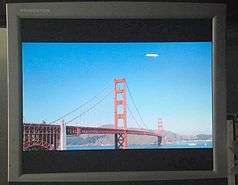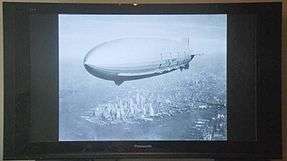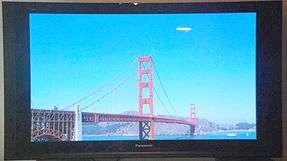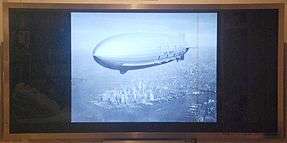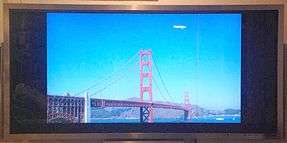21:9 aspect ratio
21:9 (2.3:1) is the approximated screen aspect ratio of the true value 64:27 (2.370:1) in comparison to the common ratio of 16:9 (1.7:1). It is designed to show films recorded in CinemaScope of 2.35:1 or the modern anamorphic format of 2.39:1. The main benefit of this screen ratio is the absence of the black bars at the top and bottom of the screen when viewing content in this format, and a constant display height when displaying other content with a lesser aspect ratio.
The 64:27 aspect ratio is the logical extension of the existing video aspect ratios 4:3 and 16:9, as it is the third power of 4:3, where 16:9 of traditional HDTV is 4:3 squared. This allows electronic scalers and optical anamorphic lenses to use an easily implementable 4:3 (1.33:1) scaling factor.
The term "21:9" was chosen as a marketing term, likely first used by Philips. Due to its common denominator, 21:9 is more relatable to 16:9, the aspect ratio of regular HDTVs, rather than the correct 64:27 or 21 :9. If it actually were 21:9, the fraction could be expressed more elegantly in the reduced form as 7:3, as related to the 4:3 of standard-definition TVs.
Constant height
A 21:9 TV allows to display all content at equal height, allowing for a more balanced viewing experience.
| 4:3 content | 16:9 content | 21:9 content | |
|---|---|---|---|
| 4:3 TV |
|
|
|
| 16:9 TV |
|
|
|
| 21:9 TV |
|
|
|
Film formats and 21:9
The 21:9 digital format is positioned in between the classical cinemascope aspect ratio, and the aspect ratio of modern anamorphic cinematic content, approximating both with only a slight deviation.
| Format | Aspect ratio |
|---|---|
| Cinemascope (1950s–1970s) | 2.35:1 |
| "21:9" (64:27) | 2.370:1 |
| Anamorphic, modern cinema widescreen format | 2.39:1 |
Standardization
HDMI
As of May 2013, video timings in this 64:27 aspect ratio are supported by the technical specification that defines video timings for the HDMI interface, CEA 861-F:[1]
- 1280×720p, anamorphic pixel aspect ratio of 4:3
- 1680×720p, near-square pixel aspect ratio of 64:63
- 1920×1080p, anamorphic pixel aspect ratio of 4:3
- 2560×1080p, square pixel aspect ratio
- 3840×2160p, anamorphic pixel aspect ratio of 4:3
In November 2016, CTA (formerly CEA) published CTA-861-G with these additional video timings in 64:27, as well as additional frame rates (48 Hz, 100/120 Hz UHD):
- 5120×2160p, square pixel aspect ratio
- 7680×4320p, anamorphic pixel aspect ratio of 4:3
- 10240×4320p, square pixel aspect ratio
All of the above timings are supported at frame rates of 23.97, 24, 25, 29.97, 30, 47.95, 48, 50, 59.94, 60, 100, 119.88 and 120 Hz.
Blu-ray
The Ultra HD Blu-ray specification was reportedly[2] to include support for anamorphic video in a 21:9 aspect ratio as well. Eventually, this feature was not included in the final specification.[3] Given that Blu-ray Discs include the letterboxing on the image, this effectively means widescreen movies will be shown in a 16:9 space, with black bars on top and bottom. The company Folded Space is working on a proprietary solution, MFE,[4] to put anamorphic 21:9 video onto Blu-rays in a way compatible with standard players.
Streaming services
Video streaming and download services use a proprietary technical infrastructure, and are not confined to the same strict rules about frame aspect ratios as standardized distribution services (such as broadcast and optical discs). They therefore often encode content as just the active frame, without any aspect ratio adjustment bars (letterbox or pillarbox bars). Movies with a 2.39:1 aspect ratio are a natural match for 21:9 output video timings, as long as the streaming clients support such video modes, and even content with other wide aspect ratios such as 2.20:1 and 2.00:1 are inherently maximizing the use of the output frame on such systems. Amazon Prime Video and YouTube support ultrawide movies/videos, while Tubi TV does not. Netflix has now added support for ultrawide displays when viewing via web browser for recent content.
Consumer devices
Flat panel TV
All Blu-ray Disc content with 1920 horizontal resolution has 1080 vertical resolution, though in the case of widescreen formats wider than 16:9, the image appears on 16:9 displays with letterboxing. Philips' "Cinema 21:9" TV eliminates the black bars by scaling the 1920 horizontal resolution to its full width of 2560 and the 800+ pixels of cinemascope images (actual pixel counts vary)[5][6] is scaled to 1080 with the black space cropped. The result is an image which fills the screen, but does not provide higher quality due to the use of scaling.[7] Despite the intention being to fill the screen with a non-letterboxed image, the zoom mode can result in some cropping at the edges.[8] Content with the full image at 1920×1080 can be displayed in the center of the screen with pillarboxing, and should the viewer choose to not display cinemascope content at full width, it appears windowboxed.
Philips
The Philips "Cinema 21:9" TV was the first LCD television of this aspect ratio.[9] The first model launched was a 56-inch screen size, although it was no taller than a conventional 16:9 42-inch television. Models released in 2010 and 2011 had screen sizes of 50 and 58 inches.
Early reviews claimed that it was "one of the coolest TVs" to enter the market for some time.[8] This set was previewed in the UK in advance of its release date of 18 June 2009. Pre-release launch events were held at numerous Philips retailers throughout June 2009.
The online advertising campaign surrounding the Cinema 21:9, titled Carousel, went on to win the most prestigious award in the advertising industry, the Grand Prix at the Cannes Lions International Advertising Festival.[10]
In 2012, Philips stopped production on all its 21:9 televisions due to lack of demand.[11]
Vizio
Vizio has since followed suit with their own Cinema TVs with identical resolution, similarly marketed as "21:9" in the United States.[12][13]
The 58-inch TV with a panel resolution of 2560×1080p has been sold in 2012 and 2013, and has since been discontinued. A planned 50-inch model never made it to market.
LG
LG has a number of monitors with a panel resolution of 2560x1080 (64:27) or 3440x1440 (43:18), and a 21:9 aspect ratio, the 25UM58P, 29EA93, 29EA73, 29LN450W, 29UM67, 29UM68P, 29UB67 as well as the 34UM95 and its curved version 34UC97.[14] Other monitor manufacturers, such as Asus, Dell,[15] NEC and AOC, have since followed suit.
At the CES 2014, LG presented the 105UC9,[16] a 105-inch curved LCD TV with a 5120×2160p panel, one of the first two Ultra-Wide 5K 21:9 screens. LG started selling the TV in early 2015 for approx. $100,000[17] in the U.S., the only 21:9 TV in the market that year.
Samsung
Also at CES 2014, Samsung presented a 105-inch curved LCD TV[18] with 5120×2160p as well, the other first UW5K 21:9 screen.
BOE
Chinese panel manufacturer BOE presented an Ultra-Wide 10K 21:9 TV with a resolution of 10240x4320 (UW10K) at the 2015 Display Week conference.[19]
Front projection
Wide screen projectors with a 16:9 aspect ratio can be converted to 21:9 by attaching a 4/3 vertical stretch or horizontal squeeze anamorphic lens. This will optically scale standard projection images with e.g. 1920×1080 (FullHD) or 3840×2160 (UHD) to a 21:9 aspect ratio. These lenses are manufactured by optical companies like Isco and Zeiss, and provided to the home theater market by companies such as Panamorph.[20]
Besides projectors outfitted with anamorphic lenses, Digital Projection,[21] Projection Design[22] and Avielo[23] have released projectors that utilise 2560x1080 pixels of a 2560×1440 DLP chip with a spherical lens.
Computer monitors
While not primarily intended for cinematic content, computer displays have also made use of this and other wide aspect ratios to provide expanded desktop space. Some that approximate 64:27 are marketed as "21:9". Common resolutions and aspect ratios in the market are listed below:
| Name | Aspect ratio | Decimal value | Resolutions |
|---|---|---|---|
| "21:9" | 64:27 | 2.370 | 2560×1080, 5120×2160, 8192×3456 |
| "21:9" | 43:18 | 2.38 | 3440×1440 |
| "21:9" | 12:5 | 2.4 | 1920×800, 3840×1600, 7680×3200 |
| Super Ultrawide | 32:9 | 3.5 | 3840×1080, 5120×1440 |
| Ultra-widescreen 3.6 | 18:5 | 3.6 | 4320×1200, 5760×1600 |
See also
References
- ↑ CTA-861 Suite
- ↑ Anamorphic encoded Blu-Rays on the Horizon!
- ↑ Blu-ray Format Extension Video Characteristics
- ↑ "Folded Space – UltraWide Cinema by Panamorph". Archived from the original on 2015-02-21. Retrieved 2015-03-02.
- ↑ Native 2.35:1 Projector Unveiled By avielo optix
- ↑ "The Complete Guide to iTunes Movie Rentals, Part 2". Archived from the original on 2011-03-09. Retrieved 2011-02-02.
- ↑ Philips 56PFL9954H DigitalVersus
- 1 2 What HiFi review of Philips Cinema 21:9 TV. whathifi.com. 2009.
- ↑ Philips launches World's First Cinema Proportion Full HD 3D LED Pro TV with Ambilight
- ↑ "Film Grand Prix for Carousel", Shots, 27 June 2009. Retrieved 22 September 2009.
- ↑ Goddard, Louis. Philips discontinuing super-wide Cinema 21:9 TVs due to lack of demand. The Verge. 28 August 2012. Retrieved 18 March 2013.
- ↑ Vizio bringing 21:9 Cinema HDTV to CES with 2560 x 1080 resolution Engadget, 4 January 2011
- ↑ VIZIO Unveils Ultra-Widescreen 21_9 Cinemawide HDTV LED LCDs for the Ultimate Cinematic Experience
- ↑ 21:9 UltraWide Monitors
- ↑ Dell UltraSharp U2913WM review
- ↑ LG's 105-inch, 21:9 curved UHD TV is wide enough to be a tanning bed
- ↑ LG 105UC9
- ↑ Samsung has its own 105-inch, Ultra-Wide 5K TV to show at CES
- ↑ TV with 10K resolution exhibited by Chinese BOE
- ↑ Panamorph UltraWide Home Theater Projector Lenses
- ↑ dVision Scope 1080p
- ↑ F35 series
- ↑ optix superWide235

